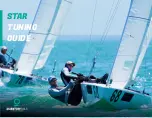
275 Performance
®
1.8
S
ection
1 • S
afety
The wind speed and wave height specified as the upper
limit for your category of boat does not mean that you
or your passengers can survive if your boat is exposed
to these conditions. It is only the most experienced
operators and crew that may be able to operate a boat
safely under these conditions. you must always be aware
of weather conditions and head for port or protected
waters in sufficient time to avoid being caught in high
winds and rough water. Do not take chances!
getting caught in severe weather is hazardous. Bad
weather and/or rough sea or water conditions can cause
an unsafe situation. Consult local weather information, or
listen to the nOaa weather reports for the latest weather
conditions or any impending deterioration of the weather
before setting out and while underway. The following are
a few basic weather-related rules:
• Check the weather forecast and the water conditions
before leaving and while underway.
• a sudden change in wind direction or speed or
an increase in wave height indicates deteriorating
weather.
• Have everyone wear a personal flotation device.
• If a storm approaches, immediately seek a safe
harbor.
• If a storm hits, have everyone sit in the cabin or on the
cockpit deck in the boat. head the bow into the wind
with enough power to maintain slow headway.
• If you encounter fog, determine your position, set a
safe course, slow down and alert other boats of your
presence with a sound signal.
• If a lightning storm approaches, the safest action is to
dock and disembark. If you cannot return to shore,
have passengers go inside the cabin and remain
there until the storm passes.
• lightning seeks ground when it strikes. The best
protection is a properly grounded lightning rod
placed high enough over the deck to provide a
protective umbrella over the hull. Depending upon
the likelihood of your being in a lightning storm,
consult your dealer for installation of a lightning rod.
If caught in a storm, stay clear of the lightning rod,
all attached wiring, and all metal parts of the boat.
• stay out of the water during a lightning storm. If
caught swimming during a storm, get back into the
boat and remain there until the storm passes.
G
eneral
c
onsiDeraTions
• know how your boat handles under different
conditions. Recognize your limitations and the boat's
limitations. Modify speed in keeping with weather,
sea, and traffic conditions.
• Instruct passengers on the fundamentals of operating
your boat in case you are unable to do so.
• you are responsible for passengers' actions. If they
place themselves or the boat in danger, immediately
correct them.
13. W
eaTher
There are four design categories of boats based
upon their ability to withstand wind and sea or water
conditions:
a. Ocean
Wind speed: above 40 knots (46 mph)
Wave height: above 4 meters (13 feet)
Boat may be used for extended ocean voyages.
B. Offshore
Maximum wind speed: 40 knots (46 mph)
Maximum wave height: 4 meters (13 feet)
Boat can be used offshore, but not for extended
ocean voyages.
C. Inshore
Maximum wind speed: 27 knots (31 mph)
Maximum wave height: 2 meters (6.5 feet)
Boat use is limited to coastal waters, large bays,
estuaries, lakes and rivers.
D. sheltered waters
Maximum speed: 15 knots (18 mph)
Maximum wave height: 0.5 meters (1.5 feet)
Boat use is limited to small lakes, rivers and
canals.
Your 275 Performance boat is Design Category C.
14. c
harT
Y
our
c
ourse
To avoid boating in unsafe areas where there are
underwater obstructions, shallow water, unnavigable
conditions such as dangerous currents, and others,
you
must chart a course
. This means having and using
the national Oceanic and atmospheric administration
(nOaa) charts for coastal waters, observing and
understanding all navigational aids, using the knowledge
and guidance of experienced boaters, and being aware
of the tide times where appropriate.
Summary of Contents for Performance 275
Page 4: ...ii 275 Performance this page intentionally left blank ...
Page 28: ...275 Performance 1 18 R Speed changes you TM This Page Intentionally Left Blank ...
Page 44: ...3 8 Section 3 Using Your Boat 275 Performance this page intentionally left blank ...
Page 52: ...275 Performance 5 4 Section 5 Fuel System this page intentionally left blank ...
Page 58: ...6 6 275 Performance R Speed changes you TM Switch Panel Wire Information FIG 6 6 1 ...
Page 59: ...6 7 275 Performance R Speed changes you TM Switch Panel Wire Information FIG 6 7 1 ...
Page 60: ...6 8 275 Performance R Speed changes you TM Wire Schematic FIG 6 8 1 ...
Page 61: ...6 9 275 Performance R Speed changes you TM Gauge Panel Electrical Information FIG 6 9 1 ...
Page 67: ...275 Performance 7 6 Section 7 Options Accessories this page intentionally left blank ...
Page 85: ...9 4 Section 9 Care Refinishing 275 Performance This Page Intentionally Left Blank ...
Page 87: ...Index 275 Performance This Page Intentionally Left Blank ...
















































